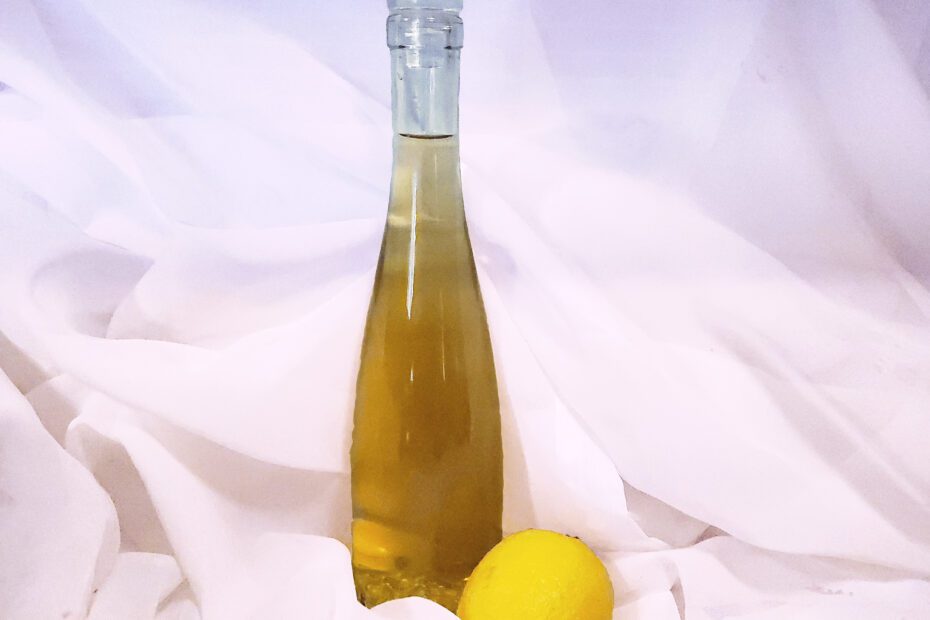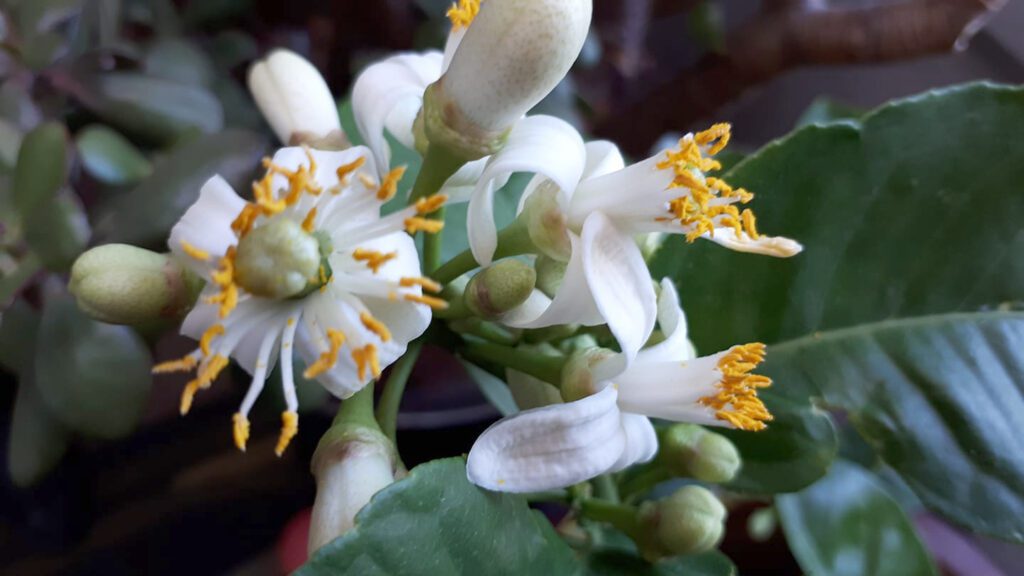
My first taste of limoncello (sounds like “lemon cello”) was over 20 years ago. I remember it like yesterday. My friend Shelley’s parents had recently visited and had introduced her to it then.
Shortly her parent’s visit, on one of our regular girls nights Shelley pulled a bottle of limoncillo from her freezer and poured us each a syrupy cold shot. It was in the heat of a Toronto summer, and it was perfect for the moment.
I have made liqueurs off and on since my early 20’s, to save money, to control the amount of sugar, and for fun. Nocino, orange brandy, cherry brandy, I’m surprised to have waited 18 or more years to make my own limoncello after trying it the first time. I think it’s the sweetness of the commercial versions. They are fun, but not something one wants to have regularly.
When making something new, I like to try variations on process to see how flavour is affected. To date, I have tried three ways of making limoncello. Each was successful in its way and all are detailed below.
At one point I was growing a lemon tree and had hoped to use my own lemons for this. Sadly, it met the Cold Dome of 2021/2022 and froze just before my first beautiful lemon was fully ripe. The tree was buried with all due ceremony (composted) and I have moved on. We now have the beginnings of a greenhouse (needs the front and back walls finished) and I’ll try to grow citrus again in 2024.
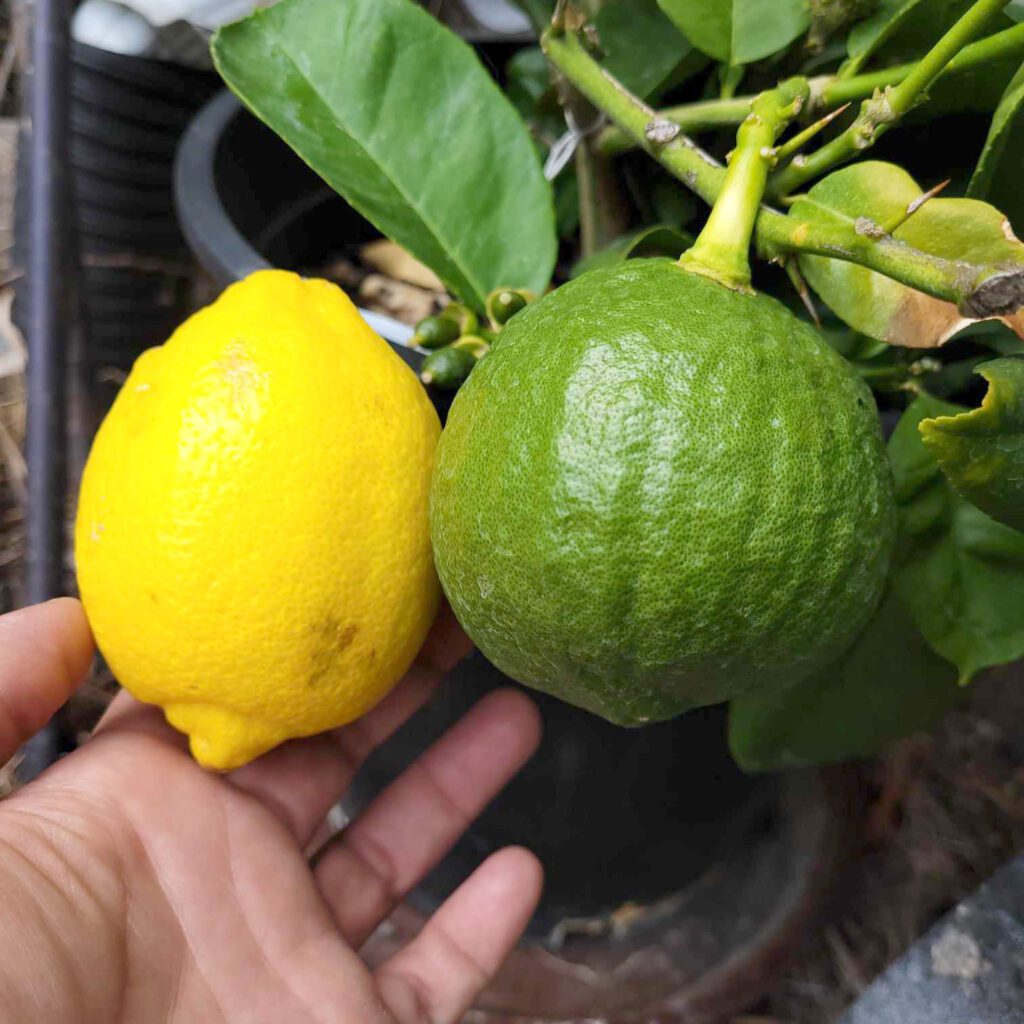
Meanwhile, I use whatever organic lemons can be found…and use them quickly, to get the best flavour. It’s lovely having my own homemade limoncello for an evening nightcap at any time of year, but especially in the summer. I may never visit the Amalfi Coast, but I can close my eyes while enjoying the sweet lemon flavor and imagine it on a nice August afternoon. Sometimes, I drink my limoncillo with a chip or two of ice, or at room temperature. This is a personal choice.
Attempt #1 Earthy with mild bitterness
For my first batch of limoncello, I decided to use the whole fruit except the seeds. The fruit was juiced, the seeds were extracted, the juice and membrane were both included. This was cooked into simple syrup, and set aside, refrigerated in a heat-sealed jar (this was not for long-term storage). I pulled the membrane away from the peel, so the peel could be more easily candied later. The lemon peels, including the white pith, went into the jar to be covered with vodka. The syrup was strained, and the membrane was used as jam.
After steeping for a few weeks to a month (it’s been a while since we did this), the peels were strained out and the resulting liquid was blended with the simple syrup until there was a balance. It had an earthy character, given the presence of the bitterness from the pith. We liked this version. It was refreshing and it went quickly, but we still kept trying other methods.
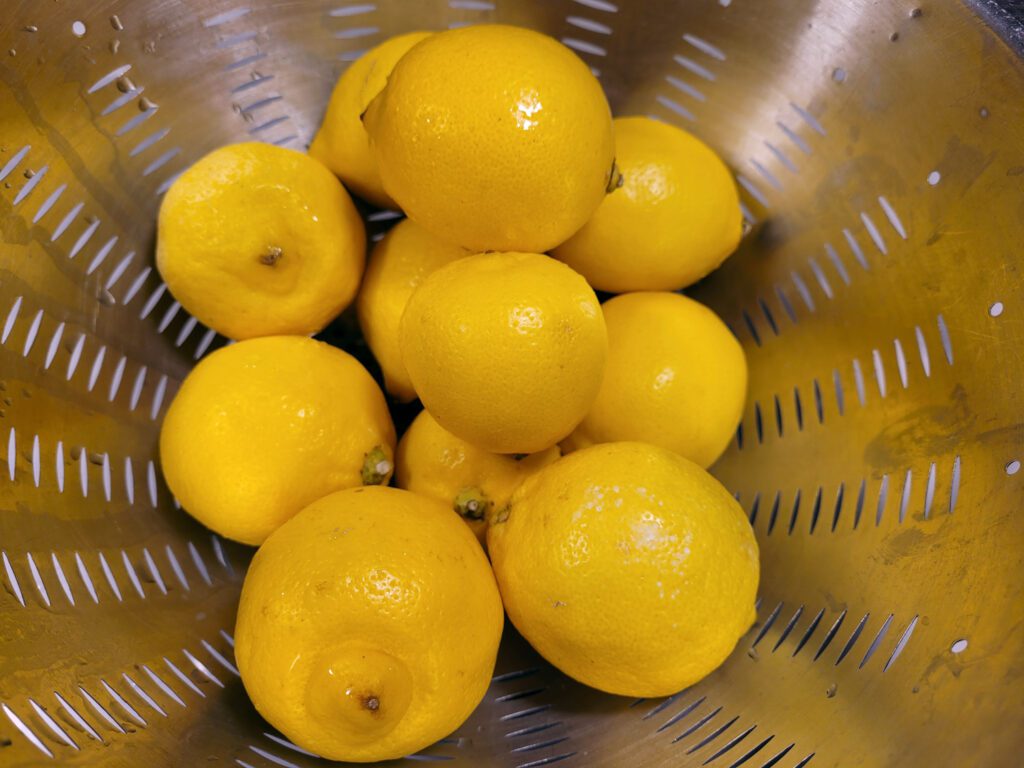
That version didn’t last long enough to know if aging could have tempered this and made it more engaging than without. Nocino , for example, is bitter at the beginning, but tempers beautifully, growing in flavour over time. It is reasonable to anticipate the same results from limoncello. If only this one had not been so tasty right away, we might have been able to know. 😉 If you try this method and are able to age it, please let me know what the results are like,
Once the liqueur was balanced, the remaining syrup was heated and the lemon peels were put into it. These were eventually used in Christmas Cake. Some peels were rolled in sugar and eaten as candied peel.
Attempt #2 Lemon Cocktail
For this second lemon liqueur, I used a vegetable peeler to get only the lemon zest (the portion of the peel that contains no pith). The lemons were peeled first and then immediately juiced, because otherwise, they are much more difficult to deal with. The juice was strained through a gold coffee filter into the same jar the peels were in. An amount of sugar equivalent to the lemon juice was also added before the vodka went into the jar. As it happens, there is no need for boiling to create a sugar syrup, so adding more sugar as one goes along is perfectly okay. So, begin with a small amount and add more as taste demands.
This version was really satisfying served on summer days and was basically a lemon screwdriver that had been aged a bit and which benefited from the depth of flavor added by the peels.
It might have tasted more like a classic limoncello if I had access to a high-proof vodka or a high proof grain alcohol to make it with. But I don’t, so you, gentle reader, must run this experiment for me if you can, and then report back to the comments below, please and thank you. Mind you, despite my love for homemade liqueurs, and a good limoncello, I don’t like to consume too much alcohol, so a lower proof alcoholic drink isn’t necessarily a detriment.
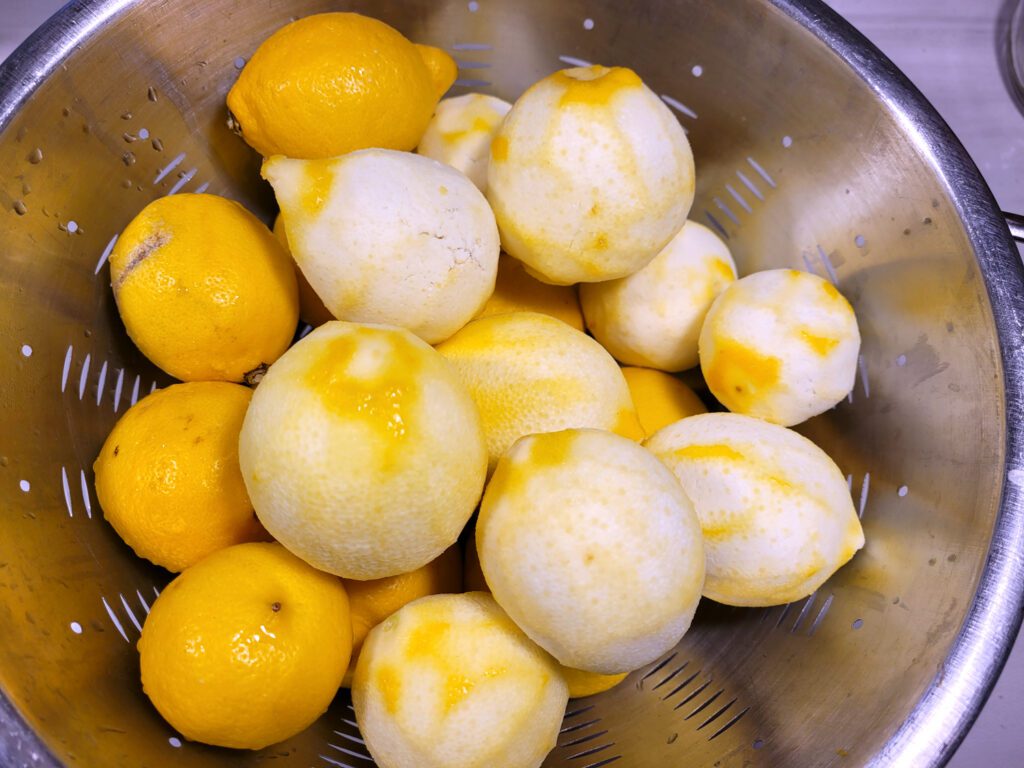
Despite its minor deficiencies, such as a slight cloudiness, the entire batch was gleefully consumed.
Both versions one and two hovered around 27% alcohol, as the addition of lemon juice reduced the relative volume of alcohol.
Attempt #3 The best limoncello so far, certainly the easiest
This is the typical version made with the most commonly available recipe and generates the most elegant looking final product with a beautiful clear amber liquid. The taste is excellent. Not necessarily “The Best”, but a very satisfying result is achieved with the least amount of effort possible.
It could not be simpler and uses only lemon peel, sugar, and vodka, or a brand name Everclear if that is available to you. It is the easiest method and makes a beautiful limoncello. The only tools required are a small sharp knife, a juicer, or fork to extract the juice from the lemons. Please note, the lemon juice is not used in this recipe, but since there is no point in wasting it, you should juice immediately and either save the juice, or use it in another recipe that calls for lemon juice. If you wait the process is a lot messier.
Carefully peel the outer skin of the lemon, trying to eliminate as much pith as possible.

Drop the peels into a large glass container with a lid that will produce a tight seal. Alcohol evaporates easily if not stored in an airtight container.
Add 1/3 cup of sugar for now. You can always add more.
Pour a bottle of vodka over this.
Age for one month.
Taste and adjust the sugar levels if it is too tart for you.
A side benefit of making limoncillo is that the lemon peels can be used again after they are removed from the alcohol. I put them in a jar and pour sugar over them. This eventually candies the peels and the moisture leaches out, turning the remaining sugar into a syrup. The peels are collected and used to make my Nona’s English Fruitcake, and paneforte. The syrup is used for all the delicious things syrup is good for.
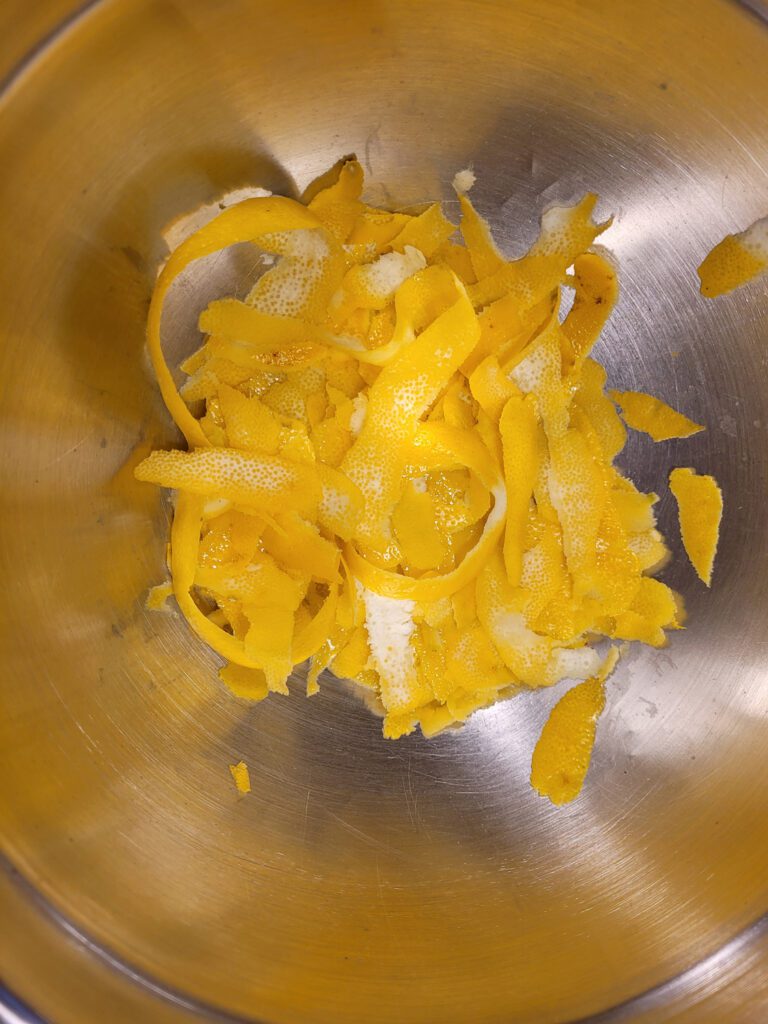

Thanks to the way that perception works, you can improve the flavor of nearly anything for little additional cost with nice packaging, my limoncello is always served to guests from a fancy bottle.
So far, we have not tried any with Meyer lemons, but I will soon. If I had a nice range of organic lemon types available simultaneously, I would love to try using various types of whatever, in this case, lemons, together to obtain the widest range of flavour notes. I’d also like to try blending a variety of citrus fruits when they are available to me organically
Store in glass bottles in a cool, dark place to preserve the beautiful colour.
Makes an excellent present alone or in a gift basket. Who would not want a delicious bottle of limoncello in a pretty container, perhaps with a small jar of lemon butter made from the fresh lemon juice not used in the limoncello, and maybe some biscotti?
I may not have finished experimenting with this. While preparing the article, it occurred that not only have Meyer lemons not been explored, but I have not tried to make a version including either or both of lemon leaves and flowers. Something to try in the future. I’ll include notes on that here when this happens.
Meanwhile: “If life gives you lemons, make limoncello” Frances Mayes

Equipment
- 1 1 liter jar
- 1 Lemon juicer or fork (a fork makes an adequate substitute for a juicer if necessary)
Ingredients
- 10 Lemons Peels only, peel carefully to eliminate any white pith
- 1/3 Cup Sugar It is easy to add more to taste later
- 1 litre Vodka Good quality
Instructions
- Carefully peel the lemons, taking care not to include any white pith
- Drop the peels into a one litre jar
- Add the sugar and vodka, cap with a tight-fitting lid, and shake vigorously before putting into a dark cupboard or corner to age for a month
- After one month, taste and adjust the sugar if required
- Strain into a beautiful bottle and serve to guests at your next cocktail party
Notes
Nutrition
